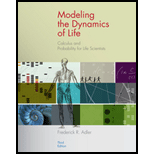
To find the predicted density of the species and to identify the species that will use most energy using the given information
Answer to Problem 68E
The predicted density of the species with the mass of
The species with a mass of
Explanation of Solution
Given information:
Calculation:
Consider the following function:
Here,
mammal.
If an unlikely
Let us substitute
When finding the predicted density of a species with a mass of
Hence, the predicted density of the species with the mass of
The predicted density is less than the initial value of
Now, the total mass of the mammals is
We know that
Thus, we get
Again, to find the predicted density of the species with a mass of
Hence, the predicted density of the species with the mass of
The predicted density is less than the initial value,
According to the metabolic scaling law,
When finding the energy used by a species with a mass of
Hence, the energy used by a species with using down mass of
When finding the energy used by species with mass of
Therefore, the energy used by a species with the mass of
So, according to the metabolic scaling law, the species with a mass of
energy.
Want to see more full solutions like this?
Chapter 1 Solutions
Modeling the Dynamics of Life: Calculus and Probability for Life Scientists
- What type (s) of translation(s), if any, affect the range of a logarithmic function?arrow_forwardWhat type (s) of translation (s), if any, affect thedomain ofa logarithmic function?arrow_forwardTable 6 shows the population, in thousands, of harbor seals in the Wadden Sea over the years 1997 to 2012. a. Let x represent time in years starting with x=0 for the year 1997. Let y represent the number of seals in thousands. Use logistic regression to fit a model to these data. b. Use the model to predict the seal population for the year 2020. c. To the nearest whole number, what is the limiting value of this model?arrow_forward
- Enter the data from Table 2 into a graphing calculator and graph the ranking scatter plot. Determine whetherthe data from the table would likely represent a function that is linear, exponential, or logarithmic.arrow_forwardWhat does the y -intercept on the graph of a logistic equation correspond to for a population modeled by that equation?arrow_forwardTo the nearest whole number, what is the initial value of a population modeled by the logistic equation P(t)=1751+6.995e0.68t ? What is the carrying capacity?arrow_forward
 Algebra & Trigonometry with Analytic GeometryAlgebraISBN:9781133382119Author:SwokowskiPublisher:Cengage
Algebra & Trigonometry with Analytic GeometryAlgebraISBN:9781133382119Author:SwokowskiPublisher:Cengage College Algebra (MindTap Course List)AlgebraISBN:9781305652231Author:R. David Gustafson, Jeff HughesPublisher:Cengage Learning
College Algebra (MindTap Course List)AlgebraISBN:9781305652231Author:R. David Gustafson, Jeff HughesPublisher:Cengage Learning


